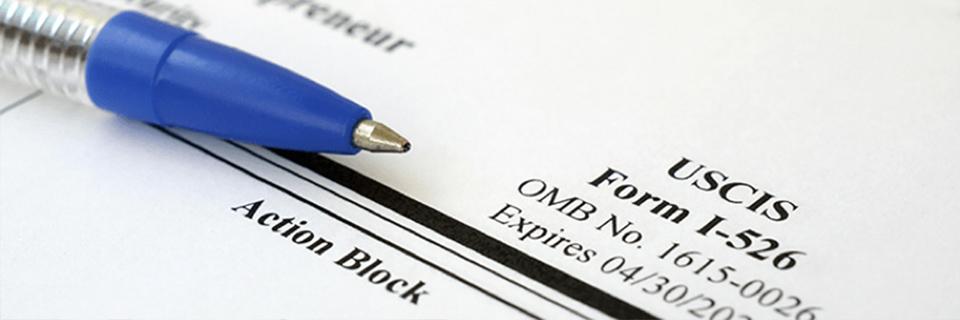
Obtaining a United States Green Card through the EB-5 Immigrant Investor Program can seem complicated. In fact, the complexity of the EB-5 process itself can become an obstacle for potential investors when deciding whether to apply for the program. However, with some insight and perspective, the EB-5 program can be simplified, and the process can be easily navigated one step at a time.
This article will provide a step-by-step overview of the program to help foreign investors navigate the EB-5 process with confidence.
Step 1: Conduct Initial Research on the EB-5 Visa Program with an Immigration Attorney
Step 2: Find One or More Potential EB-5 Projects
Step 3: Conduct Careful Due Diligence on Your Preferred EB-5 Project
Step 4: Invest the Necessary Capital in the EB-5 Project
Step 5: Work with Your Immigration Attorney to Compile Personal Documents
Step 6: File Form I-526E
Step 7: Apply for Conditional Permanent Resident Status
Step 8: File Form I-829
Begin the EB-5 Visa Process with EB5AN
Step 1: Conduct Initial Research on the EB-5 Visa Program with an Immigration Attorney

The first step in the EB-5 visa application process is to conduct thorough research on the EB-5 visa program to decide whether it fits your investment and immigration goals. It is always best to find a qualified immigration attorney to help determine whether the EB-5 program is a good fit for you.
You must also check that you meet the EB-5 visa program’s criteria. There are several factors to consider, including whether:
- You are considered an accredited investor.
- Your home country is experiencing visa retrogression.
To be classified as an accredited investor by the U.S. Securities and Exchange Commission (SEC), you must have a net worth of more than $1,000,000. Alternatively, you can qualify if you have an annual income of at least $200,000 in each of the last two years if single and $300,000 in each of the last two years if married.
Visa retrogression, on the other hand, refers to situations in which the demand for EB-5 visas exceeds the per-country limit in a given year. Historically, only 10,000 EB-5 visas are available during each immigration fiscal year, which runs from October 1 to September 30. However, this number includes the EB-5 visas for the applicant as well as their spouse and unmarried children, so the number of families that can apply for a Green Card through the EB-5 program may be much lower in any given year.
To make the distribution of available Green Cards through the EB-5 program from one country to another as equitable as possible, the United States Citizenship and Immigration Services (USCIS) puts a per-country limit on available EB-5 visas. If that quota has already been reached for a given year, then an EB-5 investor will have to wait at least one year for their Form I-526/I-526E to be processed, known as “visa retrogression.” For backlogged countries—like China, for example—where EB-5 visa demand is very high, investors may have to wait several years to begin the process of applying for conditional permanent resident status through the EB-5 program under the traditional “unreserved” category.
However, prospective EB-5 investors from these countries may be able to avoid backlogs by investing in a project located in a targeted employment area (TEA). Each year, a certain number of EB-5 visas are set aside for these kinds of projects, making it less likely that investors will experience visa retrogression.
Due to the complexities of U.S. immigration laws and policies, it is strongly recommended that prospective EB-5 investors hire an experienced immigration attorney to assist with this initial research.
What Is a Targeted Employment Area (TEA)?
A targeted employment area (TEA) is an area of the United States with a population of fewer than 20,000 people and an unemployment rate that is at least 150% of the national average. These areas are designated based on U.S. census information.
EB-5 projects located in TEAs benefit from set-aside EB-5 visas, faster processing of Form I-526E, and a lower minimum investment amount, requiring only $800,000 as opposed to $1,050,000 in non-TEA areas.
Step 2: Find One or More Potential EB-5 Projects

After determining that the EB-5 visa program is a good fit for you, the next step is to search for at least one project in which to invest that offers low financial and immigration risk.
EB-5 investors have two main options when choosing an investment project:
1. Invest Directly in a New Commercial Enterprise
Making a direct investment into a new commercial enterprise (NCE) allows an EB-5 investor to maintain active, day-to-day management responsibilities of their business. This is a good option for investors who want to run a business and continue working with it once they have achieved permanent resident status and obtained their permanent Green Card.
However, it is important to note that EB-5 program requirements are more difficult to meet when investing directly. In addition, only one EB-5 program applicant can make a direct investment in a given project.
2. Invest Through a Regional Center
Rather than making a direct investment, the vast majority of EB-5 program applicants choose to invest through a regional center. Regional centers are entities created to manage and invest EB-5 capital investment on behalf of multiple investors. As such, projects sponsored by or affiliated with a regional center can accept funding from several EB-5 investors, as opposed to just one. This means that regional centers generally offer larger projects with more EB-5 investors that have a greater chance of success.
There are several advantages to investing via a regional center, including:
- Indirect job creation: Every investment through the EB-5 visa program must create at least 10 full-time jobs for U.S. workers. EB-5 program applicants who make direct investments in a new commercial enterprise (NCE) need to employ these workers directly in their companies. However, regional center investors can also count indirect and induced jobs toward their total. Indirect jobs are those resulting from the EB-5 project’s spending on goods and services and induced jobs are those resulting from project employees spending their wages in the area. To calculate the number of indirect and induced jobs created by regional center projects, an economist performs an economic impact study. Ultimately, this means that investing through a regional center often makes it much easier to prove job creation requirements have been met.
- Faster Form I-526E approval: Form I-526E is used by regional center investors to apply to the EB-5 program. Regional centers can submit petitions to USCIS that provide information about their project. If the petition is approved, then the project section of all investor forms submitted for that regional center will be automatically approved. This can have a major impact on an EB-5 investor’s timeline for gaining conditional permanent residency, also known as a conditional Green Card.
- Limited management requirements: Regional center investors have limited management responsibilities and usually only vote on board decisions.
Taken together, these factors mean that regional center investments usually better suit EB-5 investors who care more about obtaining permanent residence status than running a company in the long term.
Step 3: Conduct Careful Due Diligence on Your Preferred EB-5 Project

Upon completing some preliminary research and selecting a potential investment, you’ll need more information about the EB-5 project to avoid fraud and ensure low financial and immigration risk. In order to perform due diligence on a project, you’ll need access to its full set of documents, which will likely require signing a confidentiality agreement. Signing such an agreement does not represent a commitment to invest in the project.
Careful, comprehensive due diligence is vital to ensure:
- A project is legitimate.
- The track records of those involved with the project are strong.
- The project itself offers low risk in terms of your capital investment.
- The project has a realistic plan to meet the EB-5 program’s job creation requirements.
- The project offers a high degree of transparency and compliance.
- The project’s assumptions and economic analyses are validated by objective third parties.
If the due diligence process reveals problems with the EB-5 project, it is best to move on to the next project in your list of potential projects and repeat the due diligence process. Again, it is always best to seek guidance from experienced immigration attorneys and EB-5 program experts during this stage of the Green Card application process.
Step 4: Invest the Necessary Capital in the EB-5 Project

Once you complete your due diligence and select a project, you must follow the procedures outlined in the offering documents to invest the necessary capital investment into the EB-5 project. This process includes filling out and submitting the offering documents and transferring your EB-5 investment, as well as any required fees, into the designated account—often an escrow account.
Again, be sure to work with your immigration attorney to ensure all laws and procedures are followed to avoid any questions about your source of funds (SOF).
Step 5: Work with Your Immigration Attorney to Compile Personal Documents

With the help of your immigration attorney, the next step in the process of obtaining conditional permanent residence status is to begin compiling all of the necessary documents for your Form I-526E, which is submitted to USCIS to request an EB-5 immigrant visa.
The list of required documents includes, but is not limited to:
- Personal information, such as birth certificates, marriage licenses, passports, etc.
- Sufficient evidence of the legal source of the capital invested, such as bank documents, employment and wage documents, documentation of gifts, etc.
- An explanation of how the investment will meet the EB-5 program’s job creation requirements.
- Other supporting documentation, including a business plan, financial and bank statements, property records, tax returns, and more.
Step 6: File Form I-526E

Once you have supplied your immigration lawyer with all of the necessary documents, they will be able to file either Form I-526, Immigrant Petition by Standalone Investor (for direct investments), or Form I-526E, Immigrant Petition by Regional Center Investor (for regional center investments).
When the petition is received by USCIS, you will receive a receipt notice, which indicates that the form has been successfully filed, and also provides you with your priority date. The priority date is used to determine when a foreign investor can expect to be allocated an EB-5 visa.
Step 7: Apply for Conditional Permanent Resident Status

Once an investor’s Form I-526/I-526E is approved by USCIS, they and their eligible family members will be able to apply for two-year conditional permanent residency status in the United States, also known as a conditional Green Card.
To do so, the immigration attorney of investors already living in the United States submits Form I-485 to USCIS, while investors living outside of the United States must instead go through consular processing. For this, they submit Form DS-260 and then attend a visa interview at the U.S. embassy or consulate in their home country. Eligible investors on non-immigrant visas who reside in the U.S. may file their Form I-485 concurrently with Form I-526E, significantly reducing the wait time.
Once this process is complete, investors will receive conditional permanent resident status and receive a two-year conditional Green Card.
Step 8: File Form I-829

Once EB-5 investors have obtained conditional permanent resident status, they are required to fulfill all EB-5 program requirements over the course of the next two years. This means that the EB-5 investor must keep the required amount invested in their selected project, ensuring that their money remains at risk while meeting the EB-5 program’s job creation requirement.
During the last 90 days of the EB-5 investor’s two-year conditional permanent resident period, they should instruct their immigration lawyer to file Form I-829. This form demonstrates that the investor has met all requirements of the EB-5 visa program. Once USCIS approves this form, the investor will be granted unconditional lawful permanent resident status and they, along with their spouse and unmarried children under 21, will receive their U.S. Green Card. EB-5 investors and their families are eligible to apply for U.S. citizenship five years after securing their Green Cards.
Begin the EB-5 Visa Process with EB5AN

These eight steps provide a summary overview of the entire EB-5 process, from initial research into potential EB-5 projects to the final step of obtaining a permanent Green Card. By following these steps and enlisting the help of qualified professionals along the way, you can successfully navigate the EB-5 process to achieve U.S. permanent resident status.
EB5AN has helped more than 2,300 families from 60 countries go through the step-by-step process of becoming U.S. permanent residents through the EB-5 program. To begin your family’s journey toward becoming U.S. Green Card holders, schedule a free meeting with EB5AN today.










